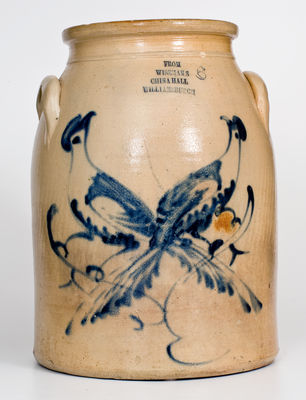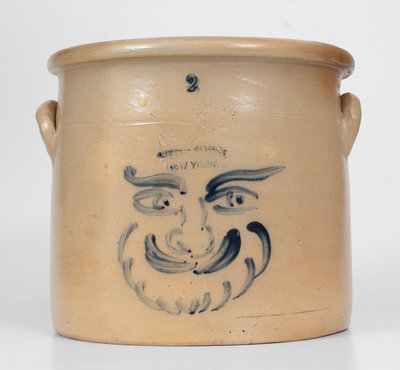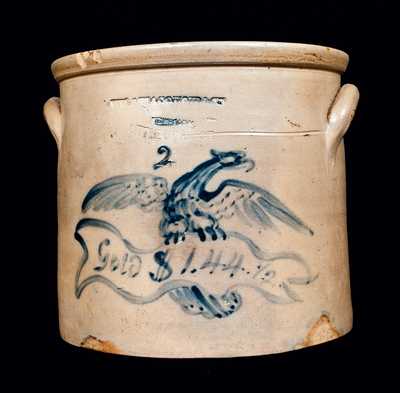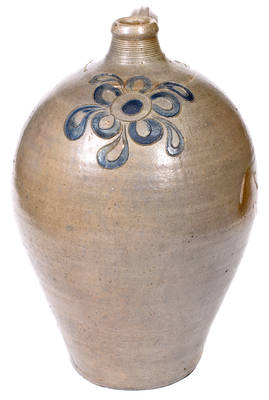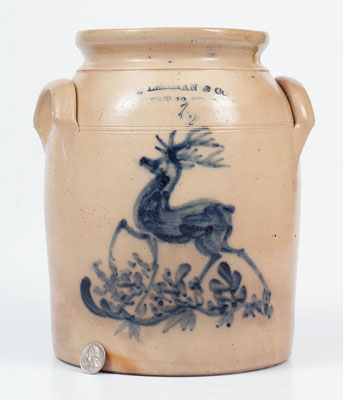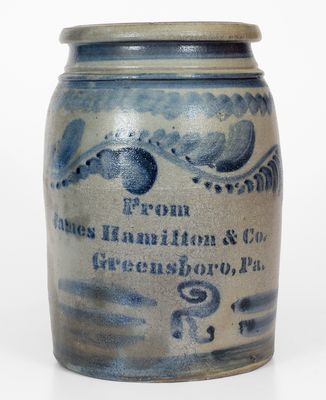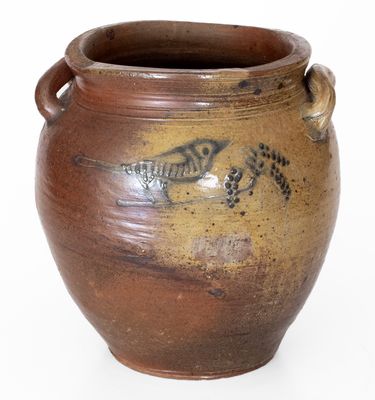The Caroline Stockwell Presentation Sugar Bowl: Exceedingly Rare and Important Cobalt-Decorated Stoneware Presentation Sugar Bowl with Incised Bird Motifs, Inscribed "Caroline Stockwell / Brooklyn / 1850," Signed "HS," Henry Stockwell, Brooklyn, NY, 1850, squat-shaped, ovoid form with flared collar and applied lug handles, featuring the incised and cobalt-highlighted inscription, "Caroline Stockwell / Brooklyn / 1850," flanked by two incised and cobalt-highlighted designs of a bird perched on a tulip. Spotted cobalt decoration emanates from the flowers and underscored the date, while a brushed swag motif decorates the shoulder. Reverse decorated with a brushed tulip emanating from a series of curved leaves, below a foliate motif. Cobalt highlights along edges of handles and surrounding handle terminals. Underside incised, "HS," for Henry Stockwell, an itinerant New York and New Jersey potter documented to have been active in various locales from 1820 onward: Troy, NY (1820, 1829); Utica, NY (1828); South Amboy, NJ (1830); Poughkeepsie, NY (1843); Manhattan, NY (1849). (See Ketchum, Potters and Potteries of New York State, pg. 209; Doggett's 1849 New York City Directory. The rare maker's mark "HUMISTON & STOCKWELL / SOUTH AMBOY NJ" was used by him). Born circa 1801 in Vermont, Stockwell appears in the 1850 federal census as a potter in Brooklyn and in the 1850 Brooklyn city directory as a potter living at 30 Hudson Ave. A well-documented jug with incised bird decoration, in the collection of the Brooklyn Museum, was made nearly two decades prior by Stockwell at William E. Warner's Columbian Factory in Perth Amboy, New Jersey in 1831. Stockwell made this sugar bowl for his daughter-in-law, Caroline Messenger Stockwell, who was also living in Brooklyn about this time; Caroline's husband, Thomas--Henry Stockwell's son--would eventually serve in the 51st New York Infantry and sadly lose his life in September 1862 at the Battle of Antietam. This bowl, rare in form and lavish in its decorative treatments, is regarded as the finest example of Brooklyn stoneware known, adding depth to our understanding of the quality of pieces produced in New York City outside of Manhattan. An approximately 2" by 7/8" professionally restored loss to rim on reverse. A small chip to exterior of rim and two small chips to interior of rim. Wear to edges of handles. A tight line across underside and additional crazing to underside, not visible on interior, forming an approximately 2" Y at base. A small in-the-firing ping at base on front. H 5 3/8" ; Diam. (at base) 5 1/4".










